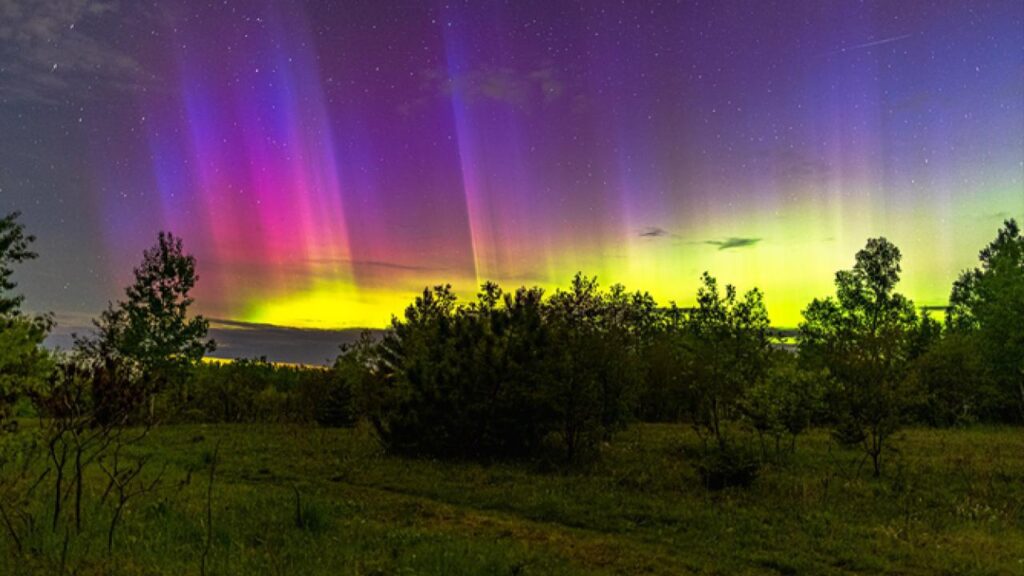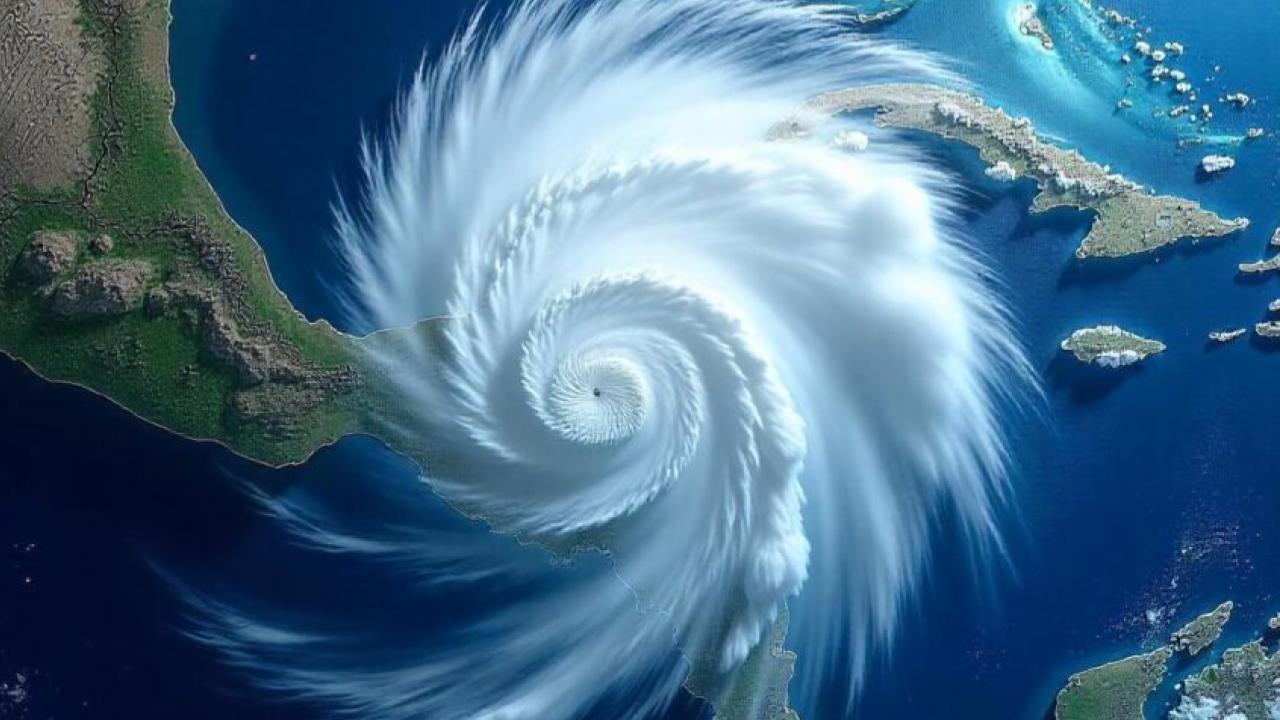A massive solar storm is hitting Earth, and it’s turning heads for all the right reasons. Thanks to a G4-class geomagnetic storm, millions of people across the United States—from northern cities to deep in the South—might see the northern lights right from their backyard. That’s right: no passport, no Arctic Circle, just step outside and look up.

This rare sky show is powered by a coronal mass ejection (CME) that blasted off the Sun on May 30, 2025. Now, the charged particles are colliding with Earth’s magnetic field, sparking glowing auroras and raising concerns about power grid and satellite disruptions.
Severe Geomagnetic Storm Could Dazzle the Entire U.S.
| Topic | Details |
|---|---|
| Event | G4-Class Severe Geomagnetic Storm |
| Solar Eruption Date | May 30, 2025 |
| Aurora Visibility Window | June 1–2 (8 PM–11 PM EDT) |
| Viewable Areas | Northern U.S., parts of Texas, Alabama, California |
| Potential Tech Disruptions | GPS, satellites, HF radio, power systems |
| Official Resource | NOAA Aurora Forecast |
This weekend’s geomagnetic storm could make for one of the most unforgettable sky shows in recent history. With auroras stretching as far south as Texas and Alabama, it’s not just a northern thing anymore. Whether you’re a stargazer, a photographer, or just someone who loves natural wonders, don’t miss this chance to see the sky put on a show.
Just remember to bundle up, get out of the city, and keep your eyes peeled to the north. Because when the Sun acts up, Earth lights up—and that’s something we all can enjoy.
What Is a Geomagnetic Storm and Why Is It a Big Deal?
Imagine the Sun throwing a tantrum—and Earth catching some of that cosmic heat. That’s basically what a geomagnetic storm is.
A geomagnetic storm happens when a giant burst of solar energy—called a coronal mass ejection (CME)—slams into Earth’s magnetic field. These CMEs are massive clouds of charged particles hurled from the Sun during intense solar flare activity. When they collide with our planet’s natural magnetic shield, it can trigger a chain reaction in the atmosphere, electricity grids, satellites, and even our skies.
The big deal? It’s not just about pretty lights dancing in the sky (although that part’s magical). Geomagnetic storms can seriously disrupt the modern world. We’re talking:
- GPS systems going wonky (bad news for planes, ships, and even your Uber)
- Satellite communications getting jammed
- High-frequency radio blackouts, which can affect emergency services and aircraft
- Power grid failures, like the 1989 Quebec blackout that left millions in the dark
- And yes—jaw-dropping auroras lighting up the sky far beyond their usual zones

These storms range in intensity. They’re ranked from G1 (minor) to G5 (extreme). The current one is a G4—severe, meaning it’s powerful enough to affect infrastructure and give skywatchers across the U.S. a front-row seat to the northern lights.
We’re currently in Solar Cycle 25, and the Sun is at a busy stage. These kinds of storms are more likely during this time, especially as we near the solar maximum—the peak of the 11-year solar activity cycle.
In short? A geomagnetic storm is space weather that doesn’t just touch the sky—it can touch our lives, from power and communication to navigation and even national security.
Where and When to See the Northern Lights
Best Time to Watch
- June 1 to early June 2, 2025
- Peak hours: 8 PM to 11 PM Eastern Time
- Activity could extend overnight if conditions persist
Best States for Viewing
Even states far from the Arctic could get a glow-up:
- Minnesota, Wisconsin, Michigan
- New York, Pennsylvania, Vermont
- Oregon, Washington
- Nebraska, Kansas, Illinois
- Possibly Texas, Alabama, Northern California
Tip: Use NOAA’s live 30-minute Aurora Forecast to track real-time visibility.
How to Photograph the Aurora—Even with Your Phone
Don’t let this cosmic light show pass without grabbing a photo. Whether you’re using a pro camera or a smartphone, here’s how to capture the magic.
DSLR or Mirrorless Camera Settings
- Tripod: Essential for stability
- ISO: 800–3200
- Aperture: f/2.8 or wider
- Shutter Speed: 5–15 seconds
- Focus: Manual to infinity
Smartphone Tips
- Enable Night Mode or Pro Mode
- Use a tripod or steady surface
- Set ISO and exposure manually if available
- Use an app like Sky Guide or Aurora Alerts
Pro tip: Head away from city lights, let your eyes adjust to the dark, and look north. You might just see the sky dance.
What’s Causing This? Blame the Sun’s Wild Behavior
This storm comes from a CME launched on May 30, during a particularly active stretch of Solar Cycle 25—an 11-year phase of solar activity that’s expected to peak in mid-2025.

Similar events during previous cycles have knocked out power grids and sent auroras as far south as Florida. The 2003 “Halloween Storms” even caused blackouts in Sweden and disrupted satellites. This one is shaping up to be just as impressive, though experts say our infrastructure is better prepared now.
Are There Any Risks?
While the aurora might be harmless to viewers, space weather like this can seriously mess with tech.
What Could Go Wrong
- Power Grids: Transformer damage, voltage issues
- Satellites: Glitches, GPS drift, solar panel degradation
- Air Travel: Flight reroutes on polar paths due to radiation risk
- Communications: HF radio blackouts (think ham radio, emergency systems)
- Internet: Satellite-based services like Starlink may see brief outages
The good news? Ground-level risks are minimal for regular folks. You can safely watch and enjoy the show.
Timeline of Events
| Date | What Happened |
|---|---|
| May 30 | Solar flare and CME detected |
| May 31 | G4 geomagnetic storm warning issued |
| June 1 | Storm begins to impact Earth’s magnetic field |
| June 1–2 | Aurora likely visible across U.S. |
| June 3 | Expected tapering off of storm intensity |
How to Prepare and Stay Safe
Aurora Viewing Checklist
- Dress warmly (even summer nights get cold)
- Bring a flashlight or headlamp with red light mode
- Use star-gazing apps to know where to look
- Stay away from city lights
- Let your eyes adjust (no phone screens for 10 mins)
Optional gear: Camera, thermos of cocoa, lawn chair, and a blanket.
Frequently Asked Questions (FAQs)
Can I really see the northern lights from my backyard?
Absolutely—you really can see the northern lights from your backyard, especially during a strong geomagnetic storm like the one happening now. When a G4-class geomagnetic storm hits, the aurora borealis (aka northern lights) can stretch much farther south than usual. We’re talking well beyond Alaska or Canada—into parts of the northern, central, and even southern U.S., depending on where you live.
Do I need special glasses or equipment to watch it?
Nope! JYou don’t need any special glasses or fancy gear to watch the northern lights. This isn’t a solar eclipse—it’s 100% safe to look at with your bare eyes.
Is this dangerous to humans?
Nope, geomagnetic storms like this aren’t dangerous to humans on the ground. You can relax, step outside, and soak in the northern lights without any risk to your health.
Will this affect my phone or internet?
Possibly, but only if you use satellite-based services like Starlink. Most ground-based services won’t notice a thing.
How often does this happen?
Strong storms like this only hit once every few years. G4-class storms are rare—this could be your best shot in a decade.










